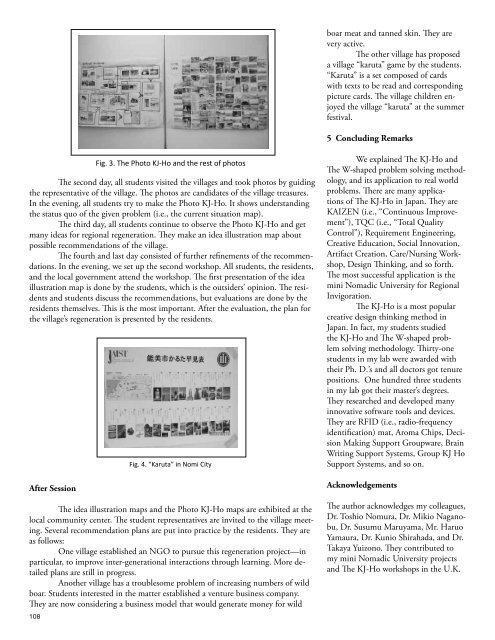Torrance Journal for Applied Creativity
TorranceJournal_V1
TorranceJournal_V1
Create successful ePaper yourself
Turn your PDF publications into a flip-book with our unique Google optimized e-Paper software.
oar meat and tanned skin. They are<br />
very active.<br />
The other village has proposed<br />
a village “karuta” game by the students.<br />
“Karuta” is a set composed of cards<br />
with texts to be read and corresponding<br />
picture cards. The village children enjoyed<br />
the village “karuta” at the summer<br />
festival.<br />
5 Concluding Remarks<br />
108<br />
Fig. 3. The Photo KJ-Ho and the rest of photos<br />
The second day, all students visited the villages and took photos by guiding<br />
the representative of the village. The photos are candidates of the village treasures.<br />
In the evening, all students try to make the Photo KJ-Ho. It shows understanding<br />
the status quo of the given problem (i.e., the current situation map).<br />
The third day, all students continue to observe the Photo KJ-Ho and get<br />
many ideas <strong>for</strong> regional regeneration. They make an idea illustration map about<br />
possible recommendations of the village.<br />
The fourth and last day consisted of further refinements of the recommendations.<br />
In the evening, we set up the second workshop. All students, the residents,<br />
and the local government attend the workshop. The first presentation of the idea<br />
illustration map is done by the students, which is the outsiders’ opinion. The residents<br />
and students discuss the recommendations, but evaluations are done by the<br />
residents themselves. This is the most important. After the evaluation, the plan <strong>for</strong><br />
the village’s regeneration is presented by the residents.<br />
After Session<br />
Fig. 4. “Karuta” in Nomi City<br />
The idea illustration maps and the Photo KJ-Ho maps are exhibited at the<br />
local community center. The student representatives are invited to the village meeting.<br />
Several recommendation plans are put into practice by the residents. They are<br />
as follows:<br />
One village established an NGO to pursue this regeneration project—in<br />
particular, to improve inter-generational interactions through learning. More detailed<br />
plans are still in progress.<br />
Another village has a troublesome problem of increasing numbers of wild<br />
boar. Students interested in the matter established a venture business company.<br />
They are now considering a business model that would generate money <strong>for</strong> wild<br />
We explained The KJ-Ho and<br />
The W-shaped problem solving methodology,<br />
and its application to real world<br />
problems. There are many applications<br />
of The KJ-Ho in Japan. They are<br />
KAIZEN (i.e., “Continuous Improvement”),<br />
TQC (i.e., “Total Quality<br />
Control”), Requirement Engineering,<br />
Creative Education, Social Innovation,<br />
Artifact Creation, Care/Nursing Workshop,<br />
Design Thinking, and so <strong>for</strong>th.<br />
The most successful application is the<br />
mini Nomadic University <strong>for</strong> Regional<br />
Invigoration.<br />
The KJ-Ho is a most popular<br />
creative design thinking method in<br />
Japan. In fact, my students studied<br />
the KJ-Ho and The W-shaped problem<br />
solving methodology. Thirty-one<br />
students in my lab were awarded with<br />
their Ph. D.’s and all doctors got tenure<br />
positions. One hundred three students<br />
in my lab got their master’s degrees.<br />
They researched and developed many<br />
innovative software tools and devices.<br />
They are RFID (i.e., radio-frequency<br />
identification) mat, Aroma Chips, Decision<br />
Making Support Groupware, Brain<br />
Writing Support Systems, Group KJ Ho<br />
Support Systems, and so on.<br />
Acknowledgements<br />
The author acknowledges my colleagues,<br />
Dr. Toshio Nomura, Dr. Mikio Naganobu,<br />
Dr. Susumu Maruyama, Mr. Haruo<br />
Yamaura, Dr. Kunio Shirahada, and Dr.<br />
Takaya Yuizono. They contributed to<br />
my mini Nomadic University projects<br />
and The KJ-Ho workshops in the U.K.


